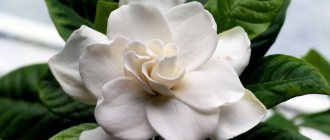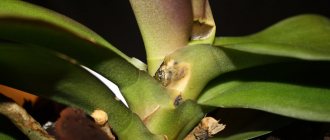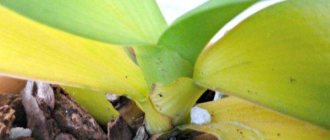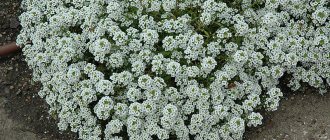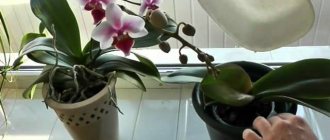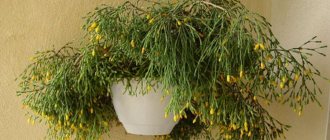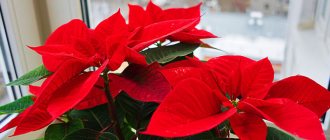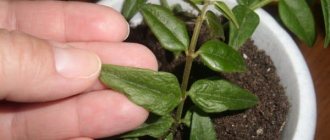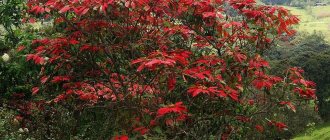When the winter bloom of poinsettia ends, it may seem that the plant is dying, but this is not the case.
Pruning and propagating poinsettias at home helps to extend the life of the flower. A timely and correctly pruned perennial produces excellent planting material, and after resting it forms young shoots and blooms profusely. A special feature of poinsettia is winter flowering, accompanied by the appearance of a rosette of brightly colored leaves-bracts. Thanks to them, the plant received a second name - Christmas star. It is not surprising that in many countries poinsettia is given as a gift specifically for the winter holidays. But when flowering ends, the compact shrub loses its decorative effect.
Beginning flower growers sometimes take the fall of leaves as a sign of death and ruthlessly get rid of the flower. There's no need to rush!
The plant just needs a period of rest, which is obligatory for poinsettias, lasting about two months, and then leaves and decorative stipules surrounding the inconspicuous flowers are formed again on the shoots.
When is the best time to propagate a plant? Is it possible immediately after purchase?
Reproduction is preferably carried out at the very beginning of summer . You should not touch the plant during the dormant period; it lasts almost 2 months, until the end of May.
After transplantation, the plant cannot be fed with anything for a month.
You should purchase a flower with closed buds, since the plant’s adaptation to a new place is long and difficult. The bush cannot be propagated for 1 month.
During the period of adaptation, the plant needs to create temperature conditions of +20 degrees ; it is strictly forbidden to allow drafts in the room.
Temperature conditions during flowering and dormancy
If in summer the comfortable temperature for poinsettia is +25, then in winter it is +14 - +16. Only with slight coolness will the plant bloom. In a warm, dry room in winter, leaves and stipules may curl and wither, and sometimes fall off.
Poinsettia blooms until the end of January - February. After this, the variegated stipules on the tops of the shoots begin to fall off and the plant enters the dormant stage. In order for the poinsettia to rest and gain strength before the new season, it needs to provide conditions for hibernation:
- Reduce temperature to +10 - +12 degrees;
- Water little;
- Avoid temperature changes or drafts.
At the end of the dormant period, the flower will have new leaves. From now on, he needs to be looked after as in summer.
Important! To awaken the plant, you can first prune it to a height of 15 cm from the ground. In April, after the end of the dormant period, the poinsettia must be transplanted into a new substrate.
What soil is suitable for growing?
Nutrient soils “Universal”, “Lemon”, “Ficus” are suitable for growing this flower.
The main thing is that the acidity should not exceed 6 units. When preparing nutrient soil yourself, you need to mix :
- 2 parts leaf soil;
- 3 parts turf substrate;
- 1 part peat;
- 1 part river sand.
As a result, the soil is as loose and light as possible.
Buying poinsettia - choosing a variety
Whatever variety is chosen, you need to pay attention to the condition of the plant before purchasing. Unfortunately, when transporting flowers to stores, all necessary conditions are not always met.
It is strictly not recommended to purchase poinsettias at markets in winter: the roots of the plants may become frozen.
Main selection criteria:
- The soil in the flower pot is not waterlogged; in this case, the roots may be rotten.
- The buds should be unopened, without pollen - this ensures that the life cycle of the poinsettia is just beginning.
- Be sure to be free of any damage or stains.
- The stems should be entirely hidden by green leaves, and the bracts should be colored in accordance with the variety.
Adaptation to home conditions is often not easy. It is necessary to help the plant, place it on a lighted windowsill, and protect it from possible drafts. For the first three weeks, there is no need to disturb the flower by replanting; carry out the procedure with the arrival of spring.
Poinsettia is popularly called the Christmas star. It blooms in December, which is very rare among indoor plants.
There are many varieties of this amazing crop, the most common are:
- Sonora White Glitter - red color with white splashes.
- Infinity White - has exquisite snow-white bracts, without streaks or spots.
- Premium Red is a classic variety with deep red bracted leaves.
- Winter Rose - Unusually curled scarlet bracts give the poinsettia a rose-like appearance.
- Jingle Bells is a mix with a popular two-tone color.
The peculiarity of each variety is mainly only the coloring, but they are cared for in the same way.
How is it propagated by seeds at home?
Under natural growth conditions, the flower reproduces by seed - self-sowing. This is difficult to do at home. Indoor representatives are hybrids, bred by breeders, and the “descendants” do not repeat all the qualities of their “parent”.
Pros and cons of the method
This method has only negative sides.
- It is almost impossible to achieve complete ripening of seeds at home.
- The hybrid plant loses its decorative qualities - flowers and colorful bracts.
- Seed material does not germinate well.
- If the outcome is positive, the plant will begin to bloom only after 3 years.
Seed selection and preparation
To obtain high-quality results, you should purchase seeds from trusted manufacturers . Breeders offer already prepared, processed seed material. Seeds for planting are selected of the same size.
Hollow planting material cannot be used. To check and disinfect, soak for 30 minutes in a weak solution of manganese. All that float are thrown away, and the rest are dried before disembarking.
Step-by-step planting instructions
- A container for growing seedlings is being prepared. You can use special containers, peat glasses or tablets.
- Light nutrient soil is poured. Any universal substrate will do.
- Abundant moistening is carried out with warm, settled water.
- The seeds are carefully laid out on the surface. Sprinkle sifted sand on top.
- The container is covered with film or transparent glass. The glass cannot be removed until the first leaves appear.
- Ventilation is required to protect against rotting and mold.
- After 3-4 true leaves appear, the flower is planted in a larger container.
Remember . A plant grown by seed will not bloom and will look different from an adult hybrid.
Experienced breeders advise propagation by cuttings. Poinsettia juice is poisonous ; when working with the plant, be careful and follow basic safety measures.
Watching the sprouts
Periodically open the film to provide fresh air to the sprouts. To prevent drying, spray the cuttings with water every time they are ventilated.
Usually, at home, the cuttings take root only after a month, and at this time the film can be removed. Established sprouts feel favorable at lower air temperatures, but it should not be lower than 16 degrees.
By mid-autumn, the sprouts turn into full-fledged plants. At this time, they need to be transplanted into pots with a diameter of twenty centimeters. Universal soil from the store is quite suitable for this.
As for flowering, young poinsettia will delight you with its first flowers only after a year. But it will be a flower that you grew yourself! In addition, the first plant from which the branches were taken will continue to live in this way.
How to propagate cuttings at home?
Division by cuttings is carried out in August or September. Propagation material is taken from an adult plant. Only well-formed and healthy shoots are used.
Pros and cons of the method
| pros | Minuses |
| A common and simple method of reproduction | Poor lighting will stop the development of the plant |
| A few healthy cuttings are enough for propagation. | If the sap is not removed, the root system will not form. |
| Following simple rules will allow you to bloom every year. | Poinsettia juice is poisonous |
| You can propagate by cuttings not only in soil, but also in water | It is necessary to control soil moisture |
| Several plants can be placed in one rooting container, thanks to this procedure the foliage will become lush and voluminous | Drafts are not allowed in a room with a growing flower. |
Selection and preparation of cuttings
It is necessary to take adult stems from a three-year-old poinsettia. The strongest and healthiest are selected. Cut into equal parts, around 4-6 internodes.
Step-by-step instructions for rooting
- The apical stem is cut into cuttings 10 cm long, each leaving at least 4 leaves.
- The cut is made under the node, the lower leaves are removed.
- To stop the secretion of juice, the cuttings are dipped in warm water for 15 minutes.
- For 4 hours, cut branches are dipped in a stimulating solution, for example “Kornevin” or “Living Force”.
- The container for planting is filled with a special substrate consisting of sand, manure and humus in a ratio of 1/1/2. You can use any nutrient soil.
- The cuttings are carefully buried to the first node, about 2 cm.
- For germination, the room temperature is maintained at +24-+ 28 degrees.
- The container is covered with a transparent film to preserve the “greenhouse” effect.
- To speed up the process, additional lighting is used using a phytolamp.
The phytolamp is located at a distance of at least 30 cm from the plant. - The seedlings are regularly ventilated, at least once a day.
- Spraying is carried out as the soil dries with exclusively warm water.
- The film is removed after 2 weeks.
- After planting, the seedling is fed with any humic fertilizer: “Humite” or “Living Force”.
- The rooting process lasts a month. After the first young leaves appear, the cuttings are pinched to begin the early formation of a beautiful bush.
- The most comfortable temperature for poinsettia growth is from +18 to +24 degrees.
- Transplantation of cuttings into large containers is carried out in the fall. Before this, a thick layer of drainage is placed on the bottom of the pot.
- The plant will be fully formed after 12 months.
Attention! To make the plant endure the process more easily, replanting is carried out with an earthen clod, the “transshipment method”.
Typical flower diseases and pests
The pungent sap of poinsettias repels many pests, but some are not deterred. And because of the gardener’s mistakes, dangerous diseases can develop.
Table: what diseases and pests does poinsettia suffer from?
| Disease or pest | How does it manifest itself externally? | Struggle | Prevention |
| Mealybug | A whitish coating, similar to dirty cotton wool, at the base of the shoots, on the petioles, on the underside of the leaf blade, leaves sticky to the touch; deformed shoots and flower buds. In especially severe cases, the plant seems to be sprinkled with flour. |
|
|
| Spider mite | Thin, almost imperceptible threads entwining petioles, bracts and curled dried leaves, rapidly increasing discolored, translucent areas on the leaf plate. In case of massive damage, clusters of pests appear at the tips of the leaves - the movement of this mass is visible. |
|
|
| Whitefly | Small whitish insects, similar to moths, fly over the flower; it is enough to lightly touch it. The leaves curl, become deformed, turn black, and the stems become thinner. |
|
|
| Thrips | Colonies of small black-brown insects, similar to flatworms with legs, settle on the underside of the leaf. It takes on an unnatural silvery-white hue, and thin “scratches” and small beige dots are also noticeable. The stems become deformed and the leaves dry out. |
|
|
| Gray rot | Grayish-white spots appear on the leaves, then become covered with long gray “lint” with small black dots inside. The fungus spreads quickly, the plant dries out sharply and dies. Individual parts turn black and fall off. |
|
|
| Fusarium | Discolored “watery” areas on losing tone, drooping leaves, a dark “mesh” in the leaf tissues, clearly visible in the light, and a black ring on the cut of the shoot. The affected plant dries quickly and the above-ground part dies. |
|
|
How to grow a flower in open ground?
In the summer, it is better to transplant poinsettia into the garden . In winter, the plant must be returned indoors; it will not grow outdoors.
For the comfortable existence of the bush, some mandatory rules of care are observed:
- For transplanting into open ground, select the most sunny area in the garden.
- The planting site is pre-fertilized with any mineral preparation intended for flowers.
- The poinsettia is transferred to the prepared place very carefully using the “transshipment method”.
- Fertilizer is applied to pre-moistened soil - this will protect the root system from possible damage. Fertilizer is applied directly to the ground every 14 days.
- This plant instantly reacts to changes in humidity. It does not tolerate overwatering, but drought is also detrimental to poinsettias.
- After transplantation, the flower must be covered with a transparent vessel.
Lighting and placement of poinsettias at home
Poinsettia is a native of the dry tropics and subtropics, which requires a lot of light for its comfortable development and flowering. However, sunburn caused by direct sunlight is dangerous.
How to choose the location of poinsettia at home so that the lighting of the flower is optimal:
- It is best to find some meth on east or west windows. In this case, the peak of illumination occurs in the morning or evening hours, and for most of the day the foliage basks under diffused but fairly bright light.
- If the pot is placed on the south side, especially in summer, reliable shading is necessary, or at midday you will have to move the decorative perennial deeper into the room.
- Northern windows are less suitable than others. Here, the lack of light is felt not only in winter, but also in the warm season, when the growing season is underway. This means that when caring for poinsettias, the grower will need special lighting.
Vegetative growth of new shoots on poinsettias begins when daylight hours reach 12 hours. In autumn, when there is less light, shoot formation is inhibited, and racemose inflorescences and bright bracts appear on the tops of the stems.
While the flower is reaching the peak of its decorative value, from approximately September to mid-November, regardless of location, poinsettia lighting at home is reduced to 10 hours. To do this, cover the bush with a light-proof cloth or box at night and move it to a dark room.
How to care immediately after planting?
The main thing is to carefully monitor the humidity level. The soil should not become crusty; overflowing is unacceptable . During the growing season, fertilizer is applied with mineral complexes at least 2 times a month.
Important! The plant drops all its leaves after flowering.
Poinsettia is considered a Christmas flower, and many gardeners try to time the plant's flowering to coincide with the winter holidays. For this purpose, at the end of September, a “night effect” is artificially created for it. Over the course of 2 weeks, the bush is covered with thick fabric for almost the whole day. Thanks to the shortening of the sunny day, the flowering process will occur just in time for the required period.
Air humidity and watering poinsettias
Properly organized watering of poinsettia and sufficient air humidity are an important part of success in growing this original plant. If during the dormant period, when growth has practically stopped, the flower requires almost no moisture, then when the buds awaken, the plant can no longer do without watering.
Irrigation water should be soft, settled and slightly warmer than the surrounding air. Poinsettia responds to the use of cold moisture by dropping its leaves, and its roots may rot.
The frequency of watering depends on the condition of the flower and soil, as well as the temperature and humidity. From spring until flowering ends, the surface of the substrate should dry out during the time between waterings. If the water that has saturated the soil passes through and ends up in the pan, it is drained.
In the hot season and winter, when the air humidity in the room is low, in addition to watering, poinsettia must be sprayed or a home humidifier used.
